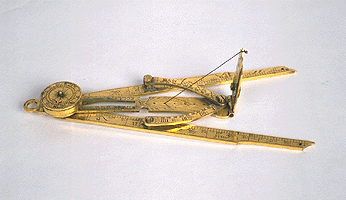 Fig. 40
Fig. 40
Dated: 1595
 Fig. 40
Fig. 40
When using a gunner's gauge, the diameter of the shot had to be taken with a pair of dividers and transferred to the gauge's scale in order to read off the weight. This German instrument represents an early attempt to provide a direct reading of weight simply from the separation of divider points.
The instrument consists of two main legs whose joint slides in the slot of a third, central leg. There are smaller link pieces connecting the side legs to the central leg. Alongside the central leg's slot are the three standard artillery scales for iron, lead and stone as well as a scale of inches. As the legs are opened or closed, the joint (which carries a compass box) moves in the slot and the edge of the compass box acts as an index to the four scales. Thus if the points on the main legs are set to the diameter of a cannon ball, the weight of the shot can be read directly from the scales.
Although the instrument is an ingenious combination of dividers and gunner's gauge, it has a drawback: since the main legs are straight, the points cannot themselves be used to measure round shot. However, this difficulty may not have mattered to the instrument's owner, as the device was presumably not a working tool: as well as its gunner's calipers, the instrument also incorporates a string-gnomon sundial and supplies tables of astronomical and calendrical information engraved on its main legs. Unusual though it is, there is at least one other surviving instrument of this pattern: a more finely executed version by Erasmus Habermel, which provides different tables (Eckhardt, p. 58).
Length: 186 mm
Inventory no. 52,589